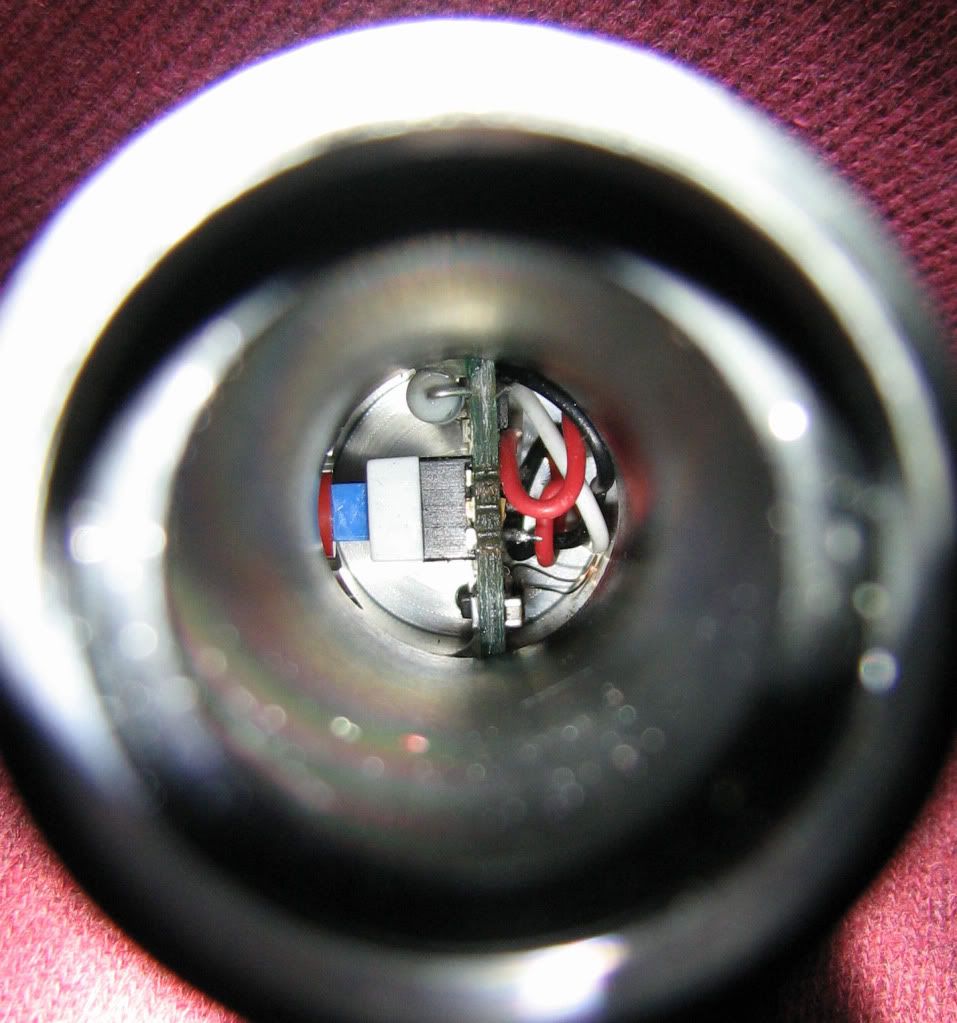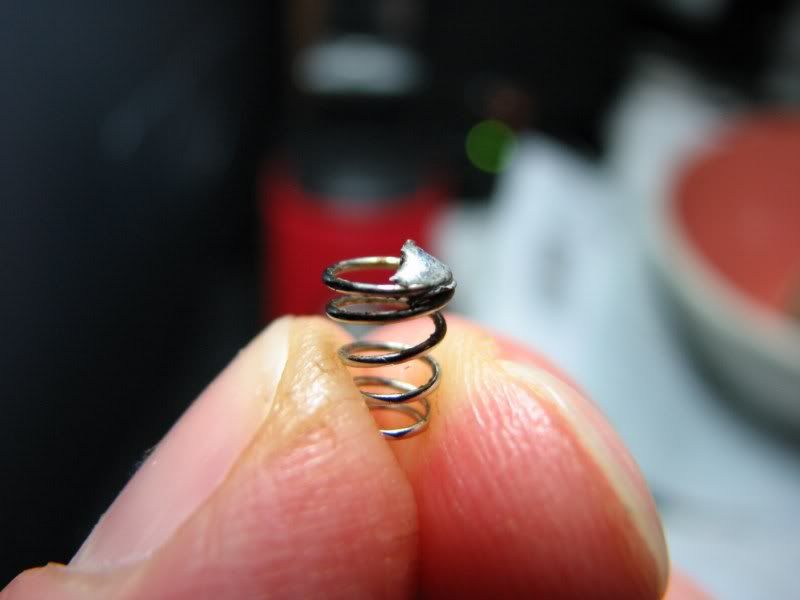plexus
0
- Joined
- Dec 9, 2007
- Messages
- 441
- Points
- 28
Purchase
I purchased this laser 9 Feb 2011 but because of the Chinese New Year I did not get a shipping notification until 15 Feb. It was shipped out on 16 Feb by the optional DHL express service. It arrived in my hand on 17 Feb (!!!) Very fast and worth the extra $15 (to me).
Appearance & Features
The laser is very well machined with a nice smooth semi-gloss surface that feels very top quality.
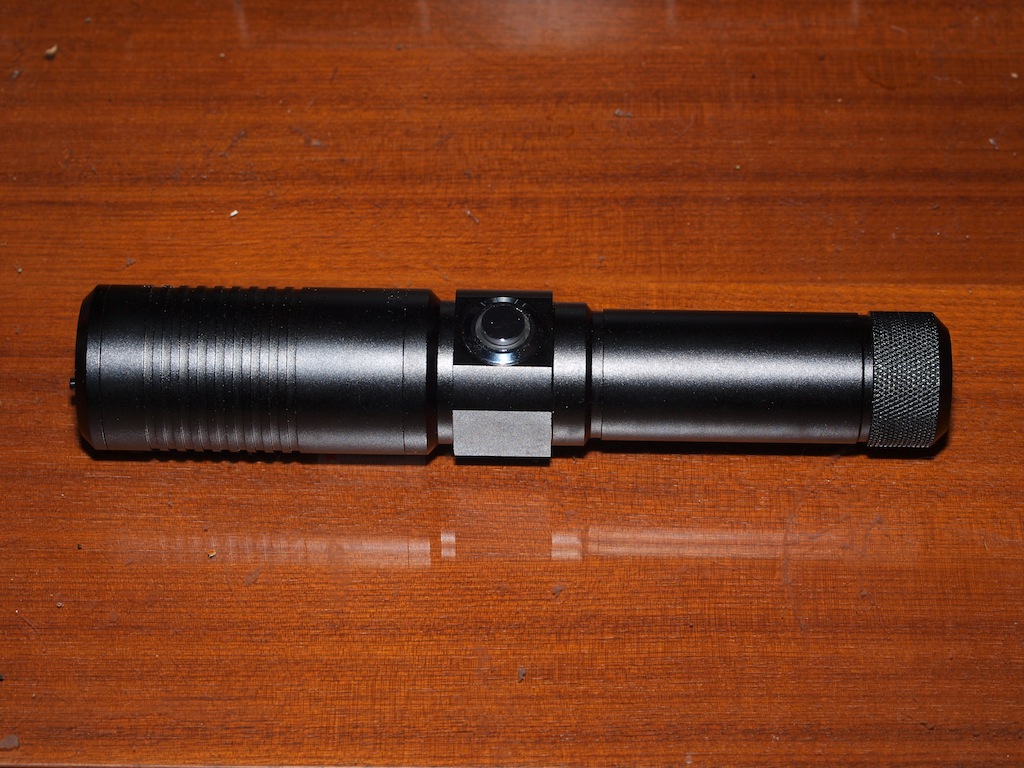
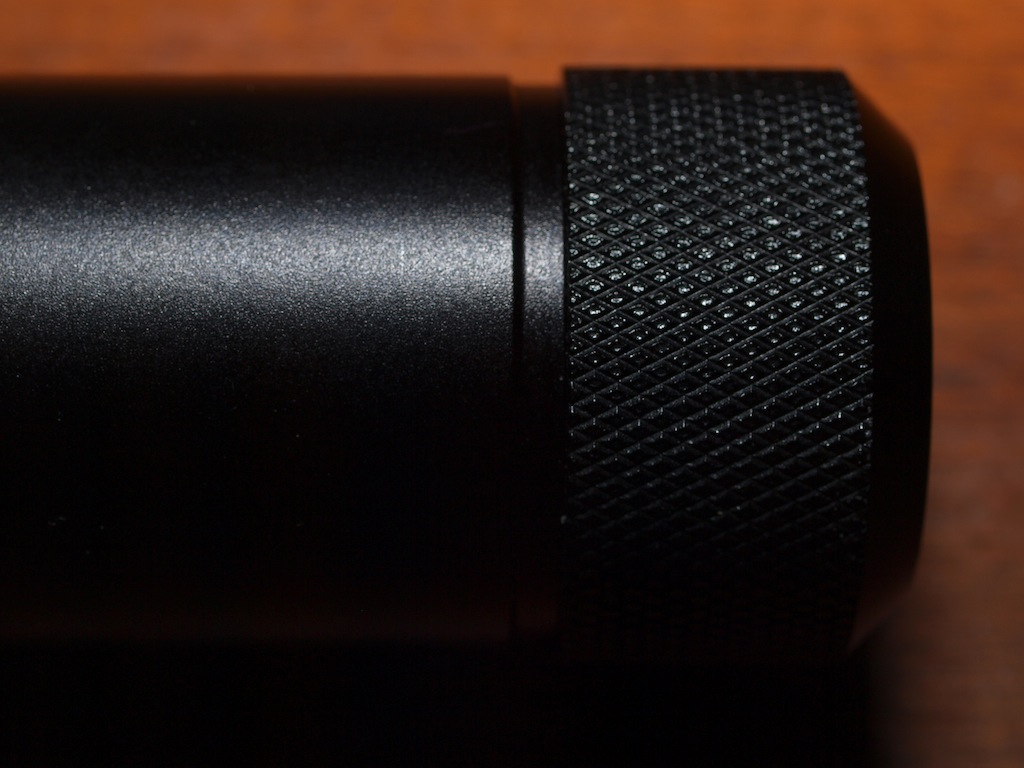
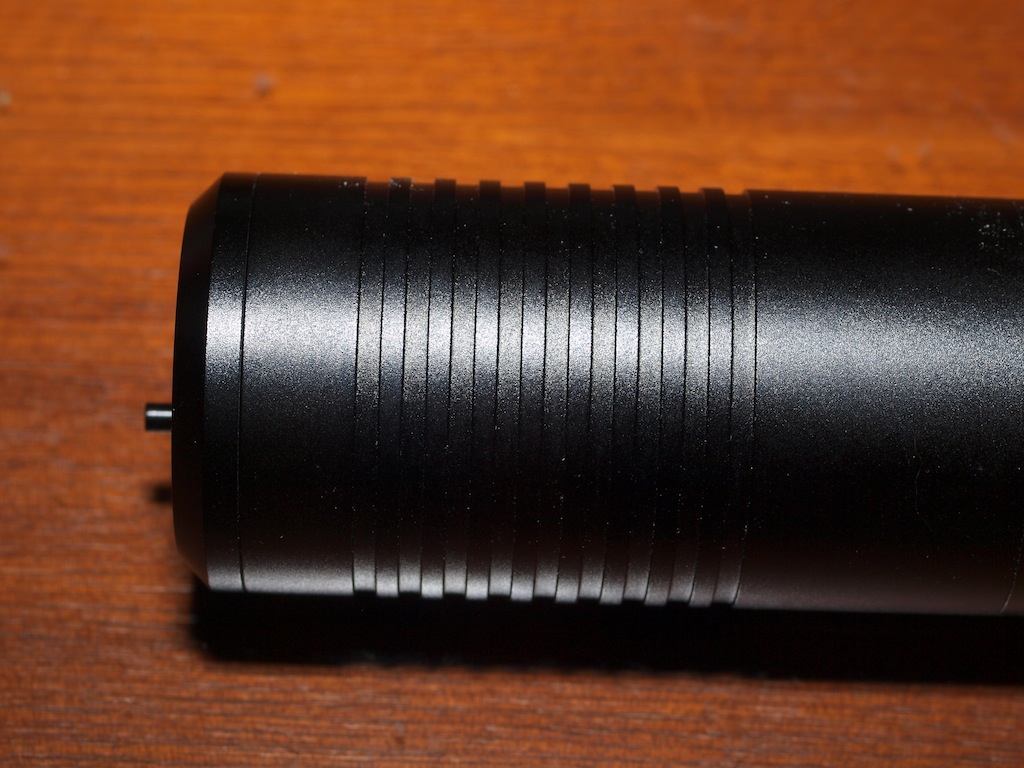
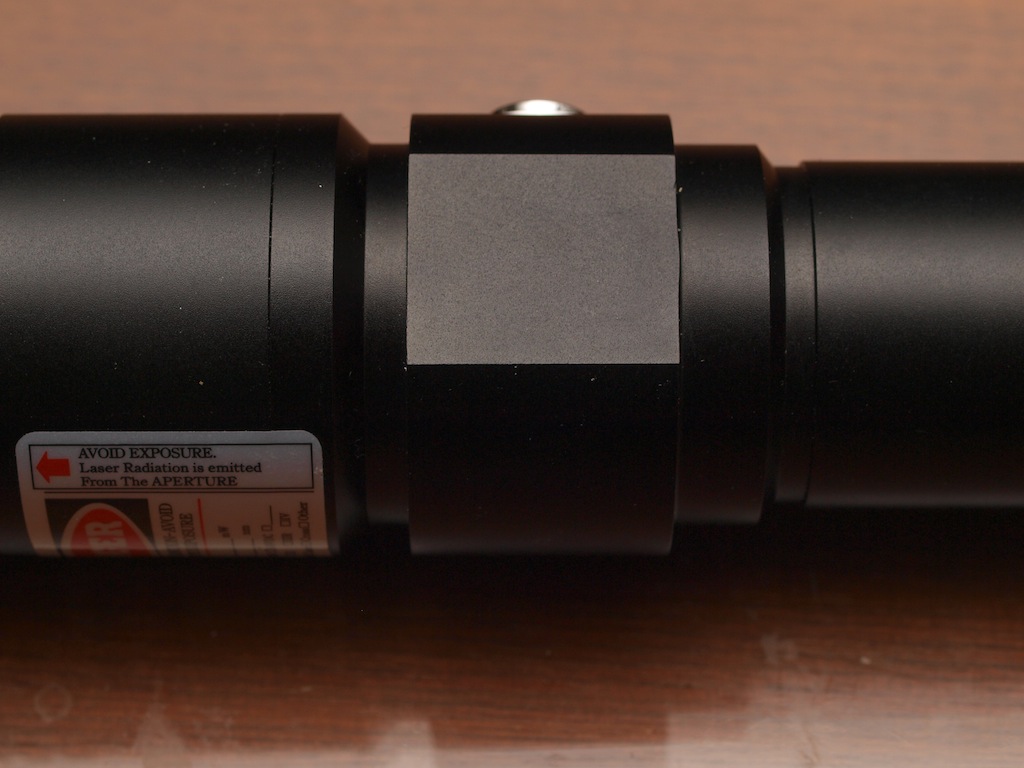
Here it is compared with some other lasers (from bottom to top: Wicked Lasers Arctic, O-like OLNG350, Wicked Lasers E3, Aurora SH302 host, O-like "Cute" 250mw 650nm):
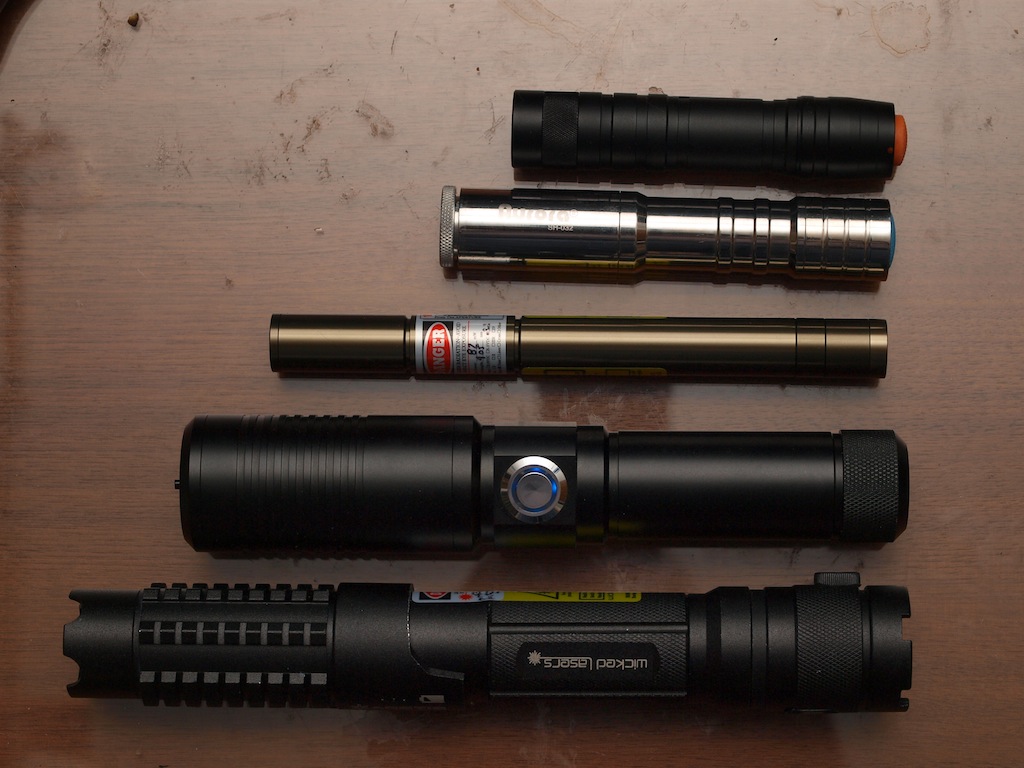
The tail cap has a key switch on it. this is actually very useful and provides for a good safety feature. the annoyance of having to use the key to arm the laser, or not is out-weighed by the safety aspect of it. The positive tail cap is well made and serviceable"
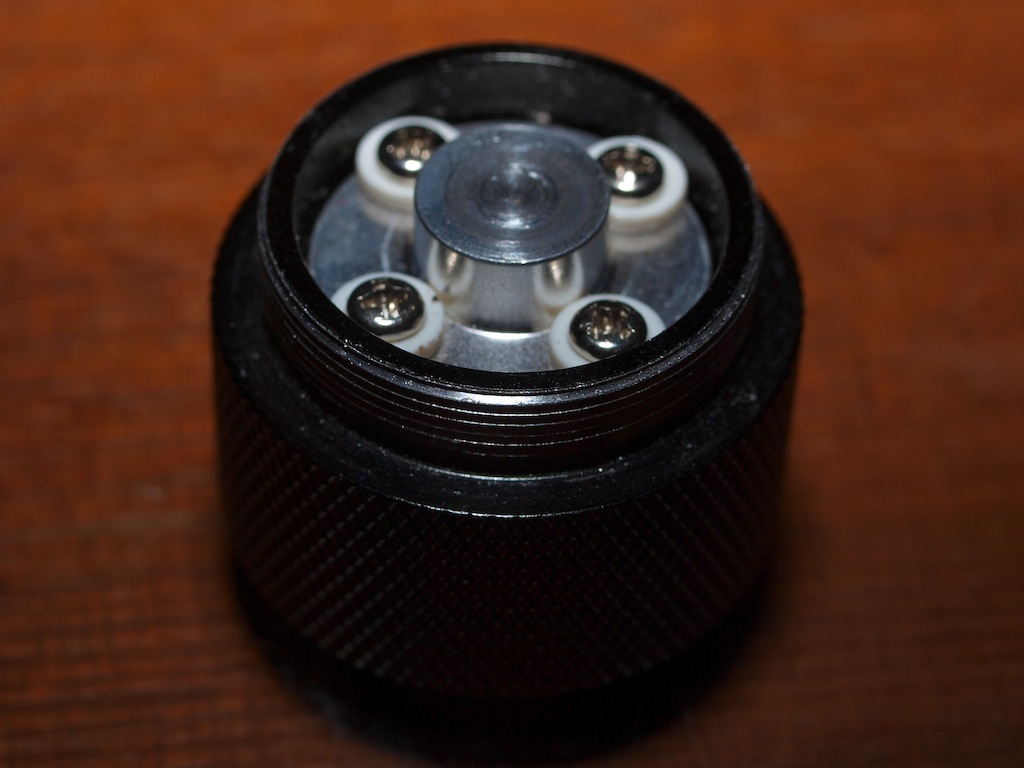
The power switch is very nice and feels nice. its a soft press toggle on/off. when off it glows blue and when on it glows red. there is no time delay.
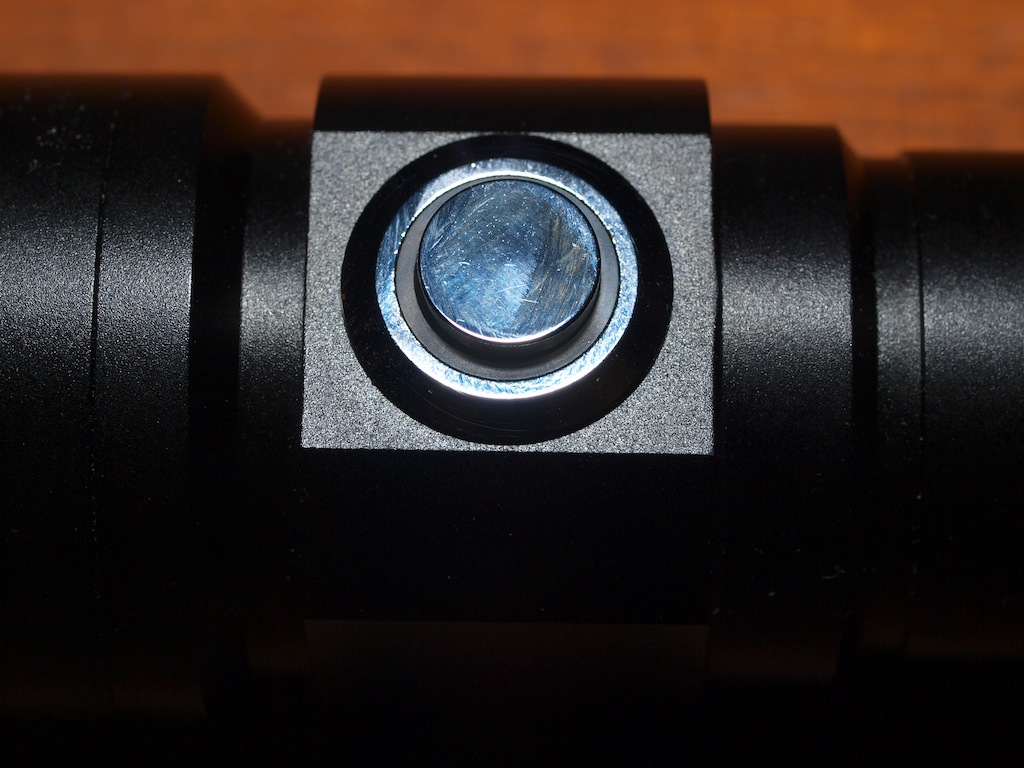
The switch is illuminated blue when the key switch is on (armed mode) and red when the laser is on. You can see the switch is illuminated with 3 board mounted LEDs.
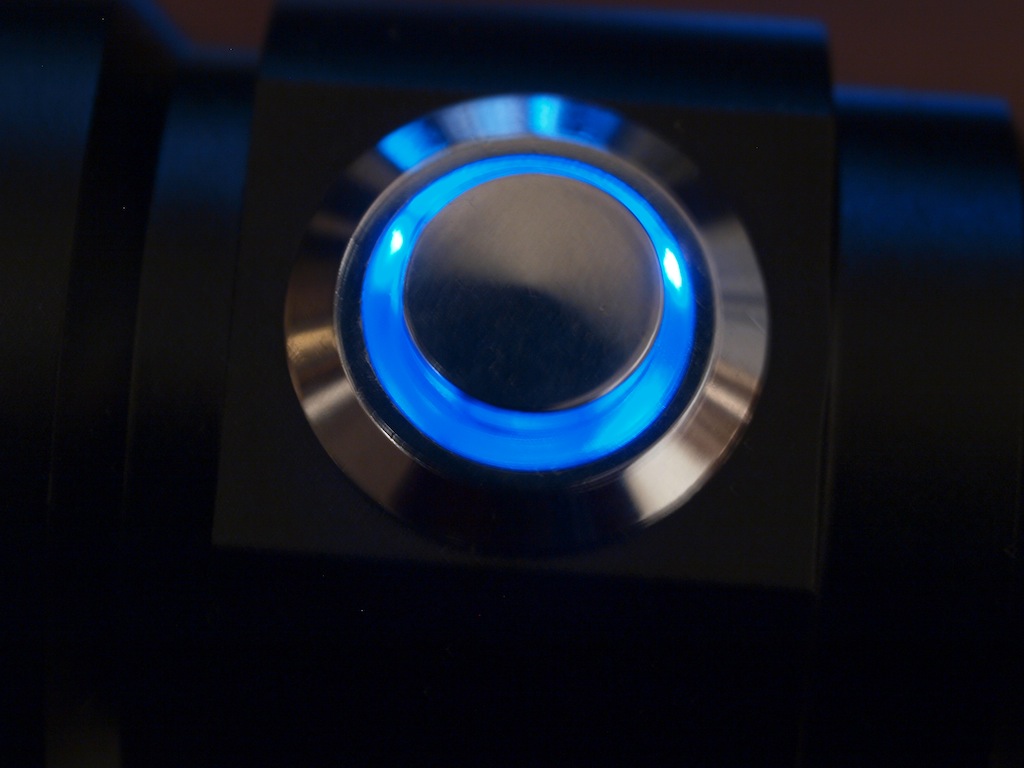
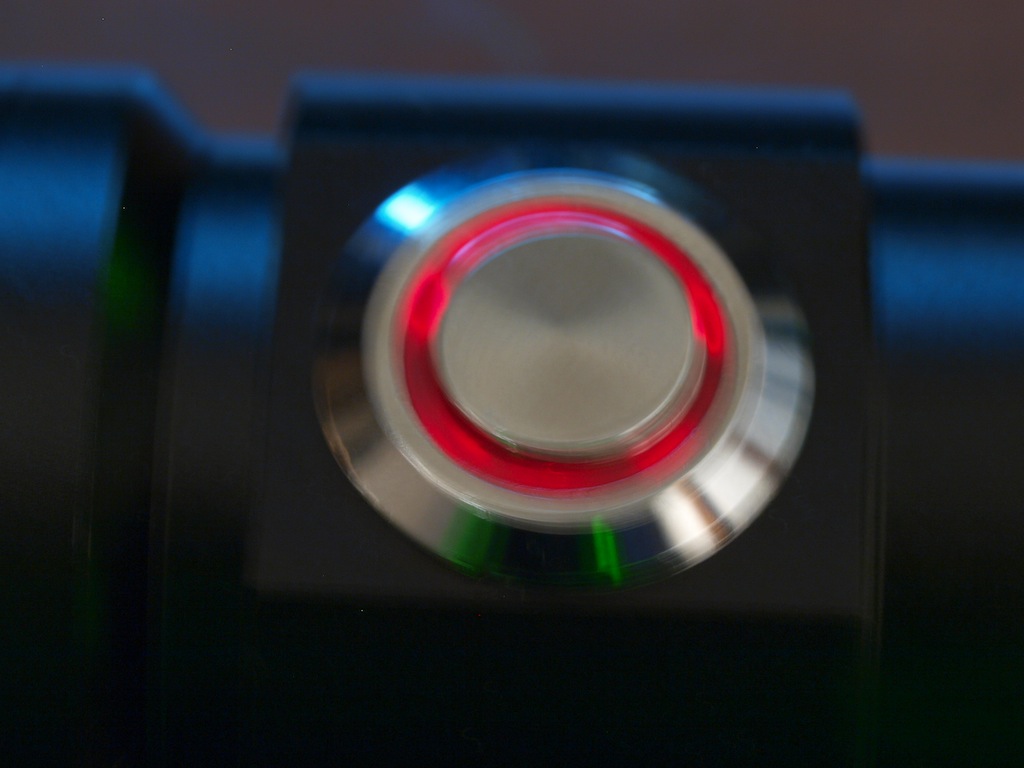
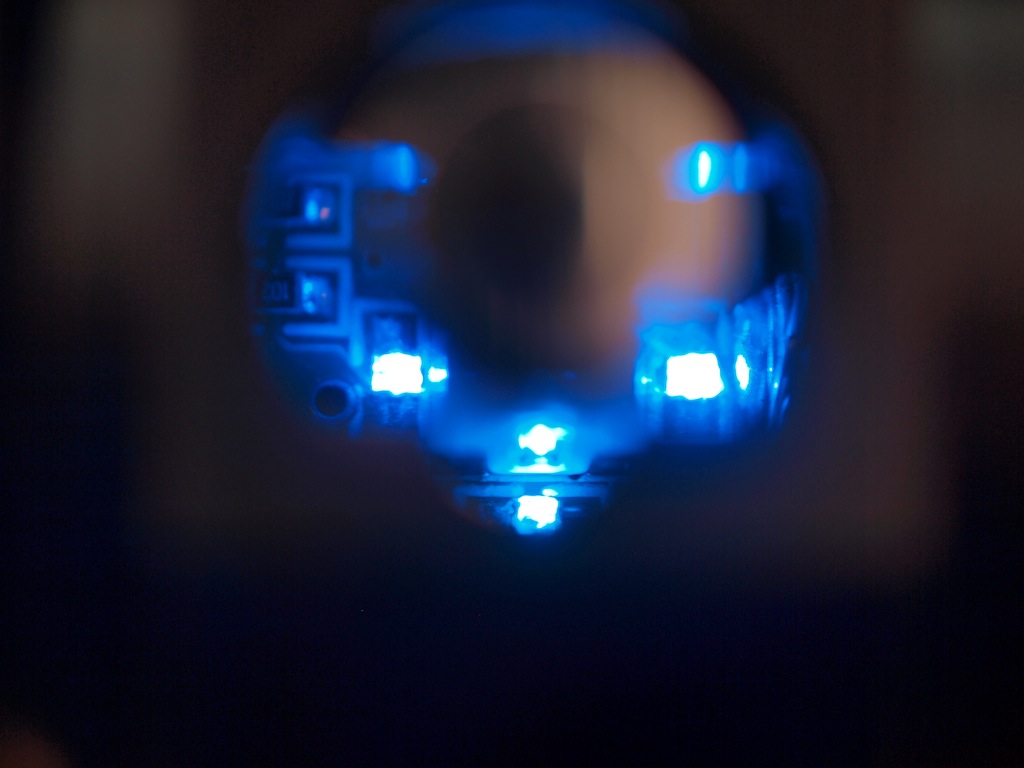
The front aperture has a manual aperture lever. pushing the lever down opens the aperture leaf and pushing it towards the aperture, closes the aperture. this is another good safety feature. i always make sure to close the aperture before i turn the laser on and then use the aperture lever to open it. this way i don't inadvertently turn the laser on while its pointed at something i don't want it to be (like my eyes). also the main switch is very soft touch so its easy to accidentally turn the laser on by accident. so the aperture leaf is a welcome safety feature.
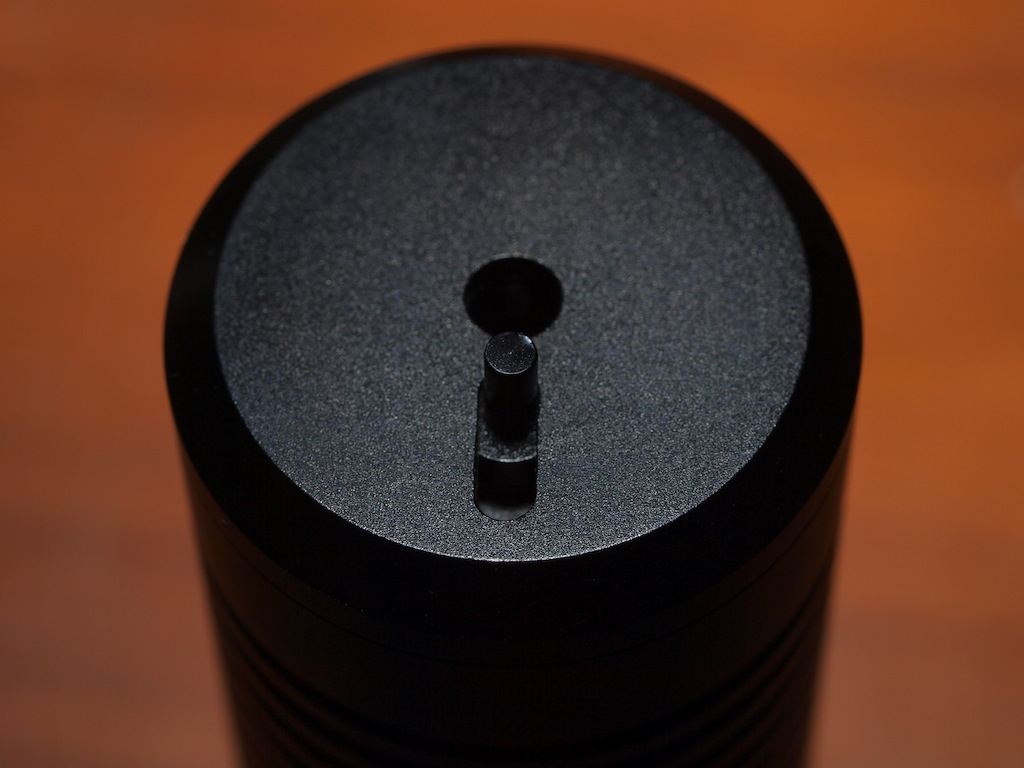
one gripe i have is that when the laser is keyed-on the blue lights are on. this means there is power draw and you have to make sure to key-off the laser before putting it to bed for the night, or else your battery will drain. but like i said having the key switch is better than not and it forces me to only key-on the laser when i am going to use it (safety).
The heat sink is quite massive and I think it might be made of brass, considering the weight of the laser and the balance of the weight toward the head. The main focusing lens is on a thin but wide disk that threads into the heat sink (I have removed the IR fliter, and the residual white silicone can be seen):
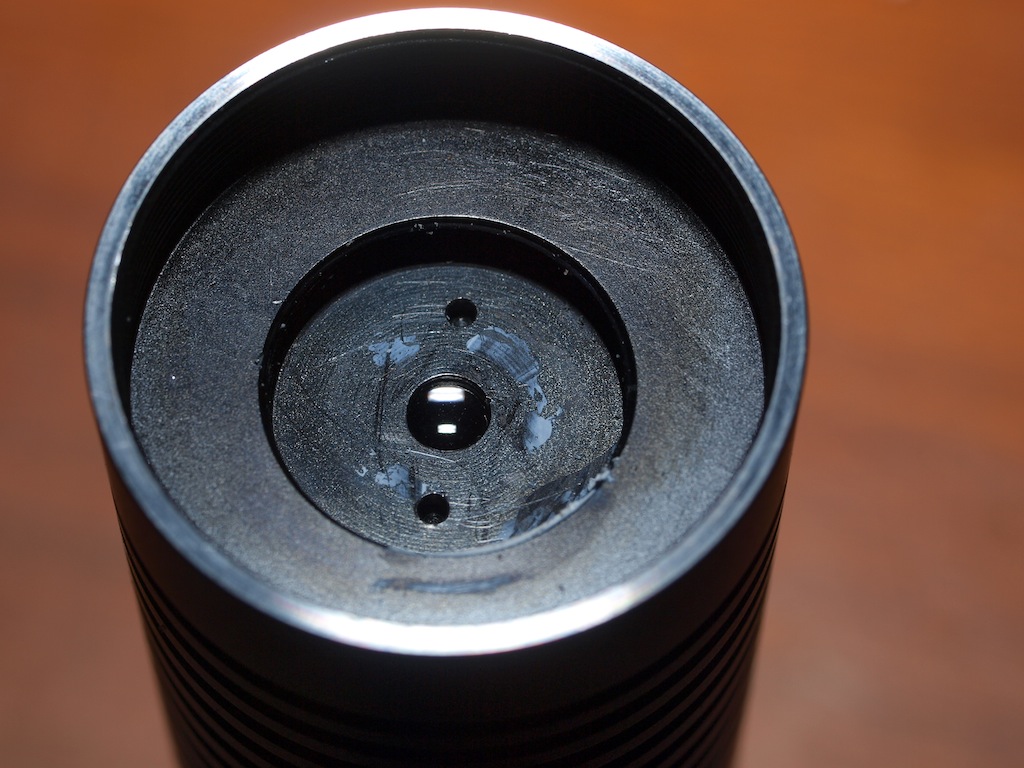
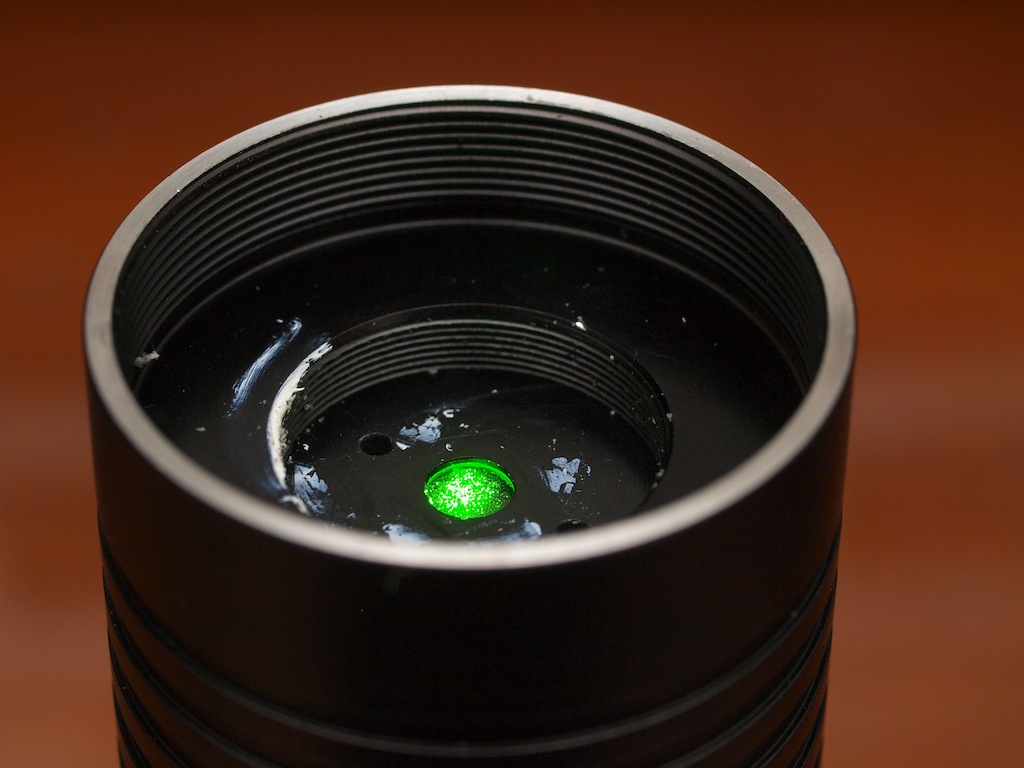
Internal Design
This is module with the focusing lens removed. you can see a secondary lens glued to the output of the module. the lenses appear to be glass:
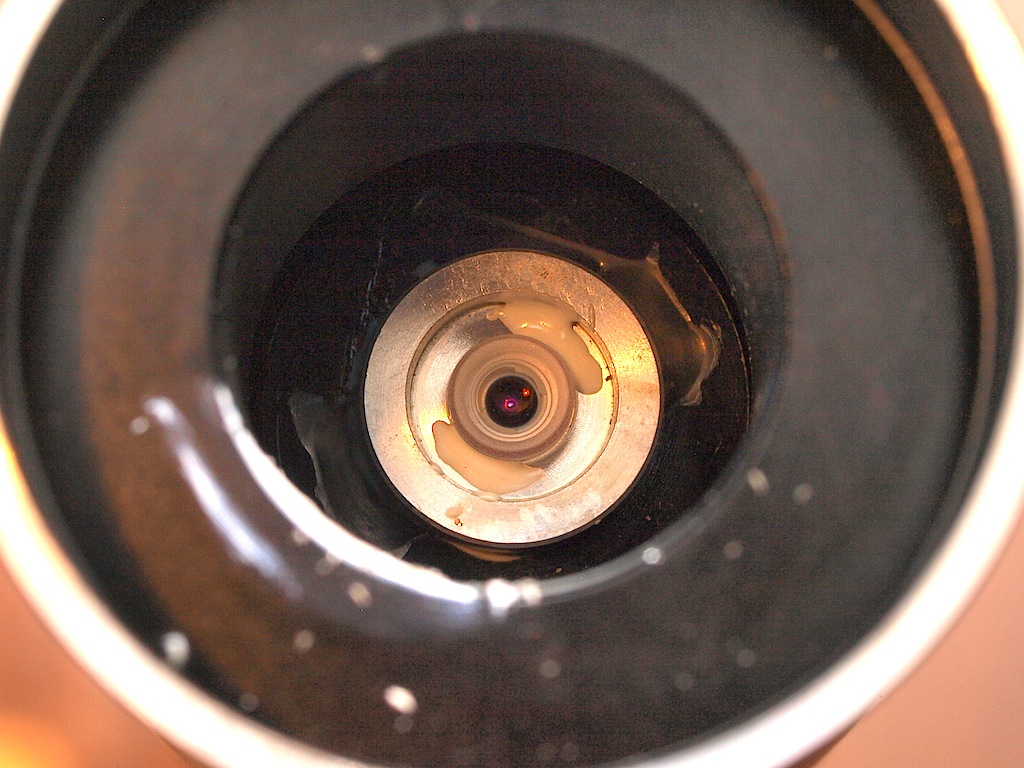
The battery compartment is a plastic sleeve inside the host. This makes the battery fit nice and snug but with enough clearance to slide out without effort. The inner battery spring has no other support so this could be a problem in the future with perhaps the spring coming loose. I hope there is a good blob on solder holding it to the driver!
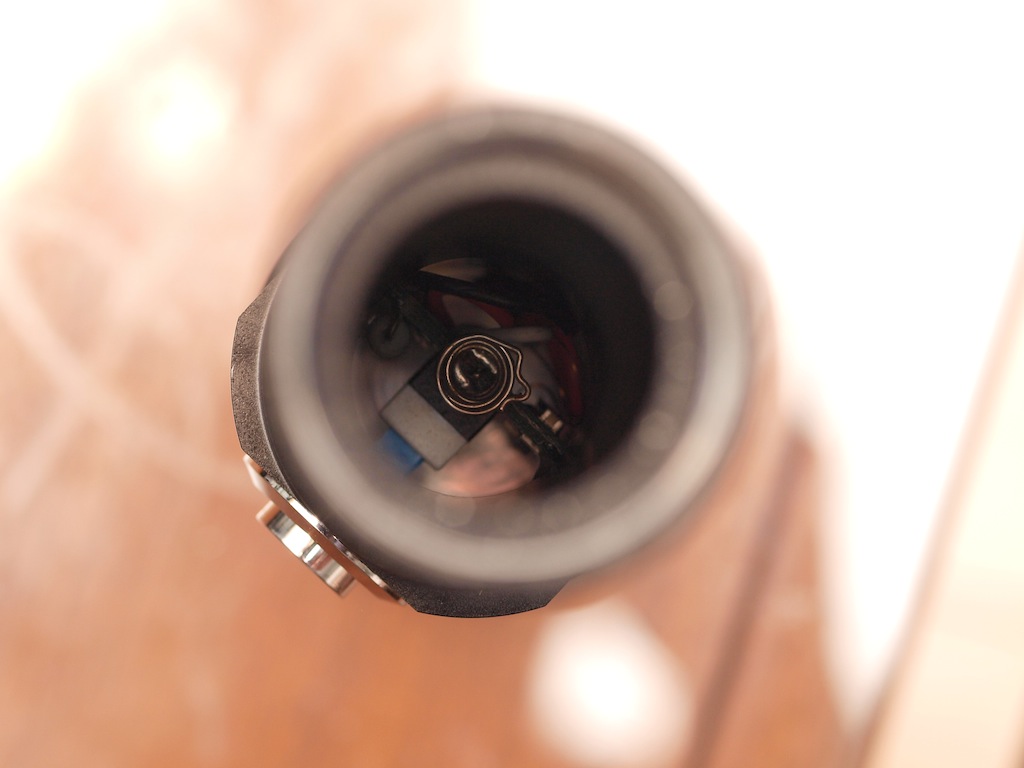
I think they are using a constant current driver because as the battery depletes the output remains quite constant (unlike the "cute" 250mw 650nm which I think is a linear driver as the output of the laser drops as the battery drains).
IR Output
I measured the stock IR filter vs another IR filter. the other IR filter i purchased from ebay and seem to be a common one used with laser diodes. however i don't know which does the best job of only filtering IR.
The stock filter is a thin piece of glass that has no tint. When the laser was outputting an average of 380mw, the stock IR filter reduced this down by 20mW, or 5.2% of total. The other IR filter (Schott BK38) dropped this down by 60mW, or 15.8% of total - 3x more IR attenuation. In the meantime I ordered a lab grade visible light pass-through filter from an ebay seller so I can get a better handle on how much IR my lasers are producing. But BK38 is pretty standard so I think the stock IR filter is only reducing the IR marginally and I would say is still at an unsafe level. BK38 attenuates the 800-1100nm region down to about 2-4%.
As a note, there is a lot of interest in DPSS lasers with IR filters in terms of whether they have them or not and how much IR is produced. We all want to trust the rating manufactures give us and we've all seen some lasers that produce upwards of 30% of their output as IR. Some people have used cheap goggle to filter out IR or even IR filters made for laser pointers. Unless a filter is used that has a measured spectral response, you will never really know for sure. If you are concerned or interested in measuring IR vs Visible you might want to consider buying a measured and documented filter for such purposes. There are often lab grade filters on ebay. When I get mine I will update this review and we will then be able to say for sure how much IR this produces.
For now, lets say the laser produces somewhere between 5-15% of IR in its total output, which pretty typical.
UPDATE: I just realized I have two IR filters for photography. Ones happens to cut off under 950nm and the other under 720nm. so perfect for measuring the IR in these DPSS lasers! also these are pretty high quality filters and I believe they are at least 85% transmissive if not more.
With the 720nm pass through I read 40mw and with the 950nm i read 26mw. so that means about 13mw of 808nm and 26mw of 1062nm. so this tells us that the stock IR filters is still letting through about 20mw of IR and that the Schott BK38 is cutting an additional 20mw of the 532nm output. for this laser, when outputting 420mw of total power to only have 40mw of IR is pretty good!
Here is a horizontal beam comparison between some similar lasers. The top is the OLNG350, middle is an Ultra Lasers 100mW pen and bottom is a 280mW labby. Notice how the OLNG350 has a wider beam waist and hence lower power density. This is, I think, because they are using larger crystals to keep the interface temperatures down. You still get more light out of it but in a wider area. The OLNG350 has a waist about twice that of the 100mW, which can use smaller crystals, and the labby which is TEC cooled. (This was a very difficult picture to capture.)
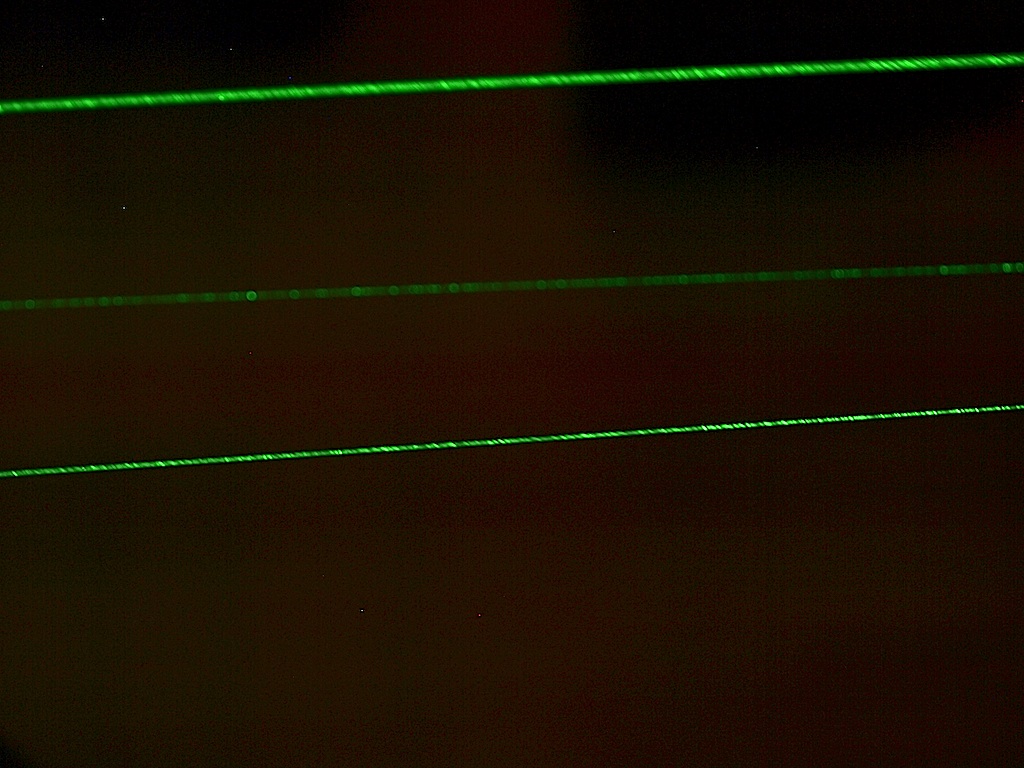
This is a picture of the laser output without the front most focusing lens.
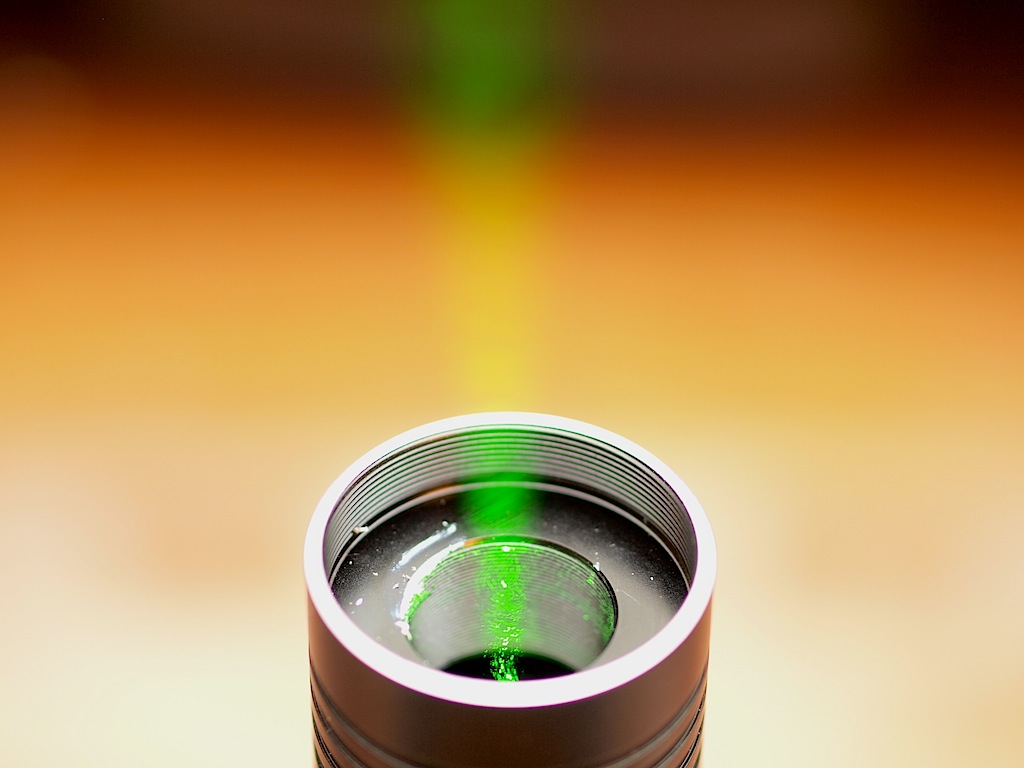
This is the beam profile, without the front focusing lens, about 2m from the aperture. The beam profile is more rectangular than round. It is pretty stable but there is some mode hop now and again. The instability is more pronounced when the laser is cool:
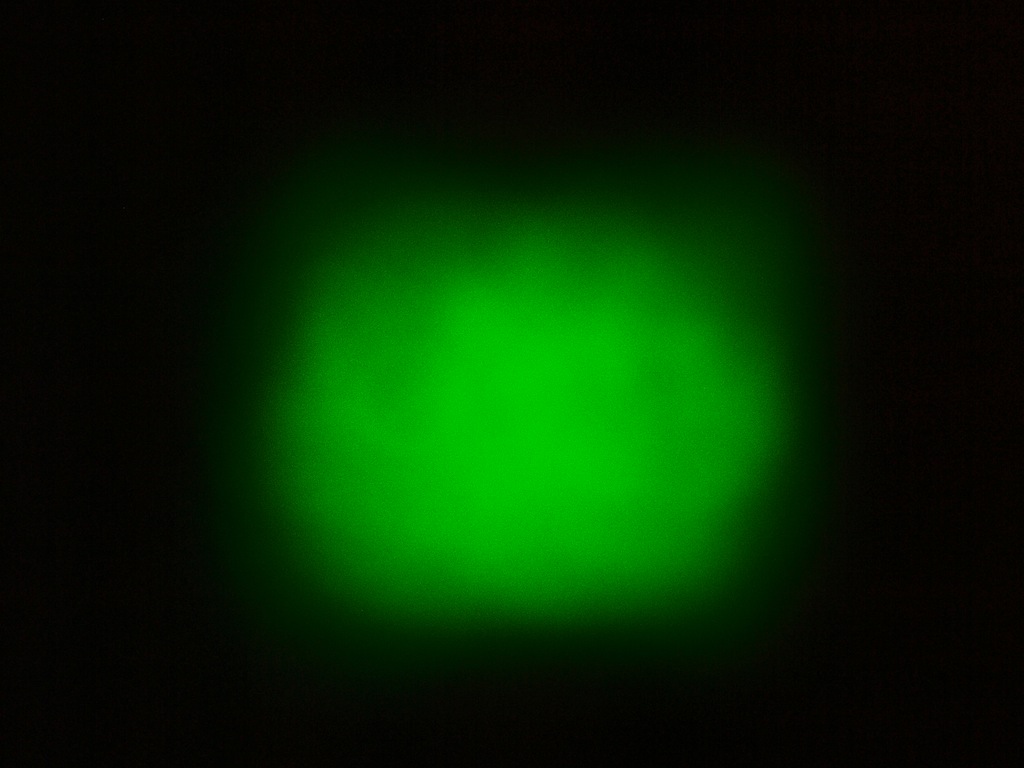
Measurements
The graphs in this review are with the stock IR filter. I did them before I thought of trying the other IR filter. so adjust your expectations accordingly.
This graph shows a 5 minute run from room temperature on a fresh AW 18650 2600mAh:
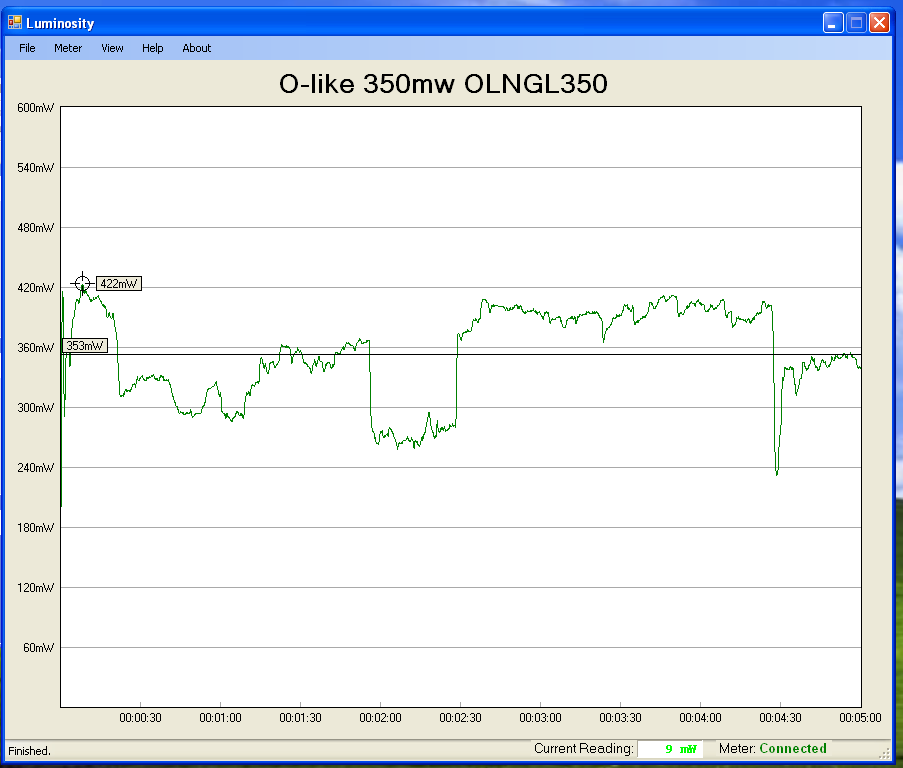
Then I switched the laser off for about 10 seconds before I started the next run from 5-10 min:
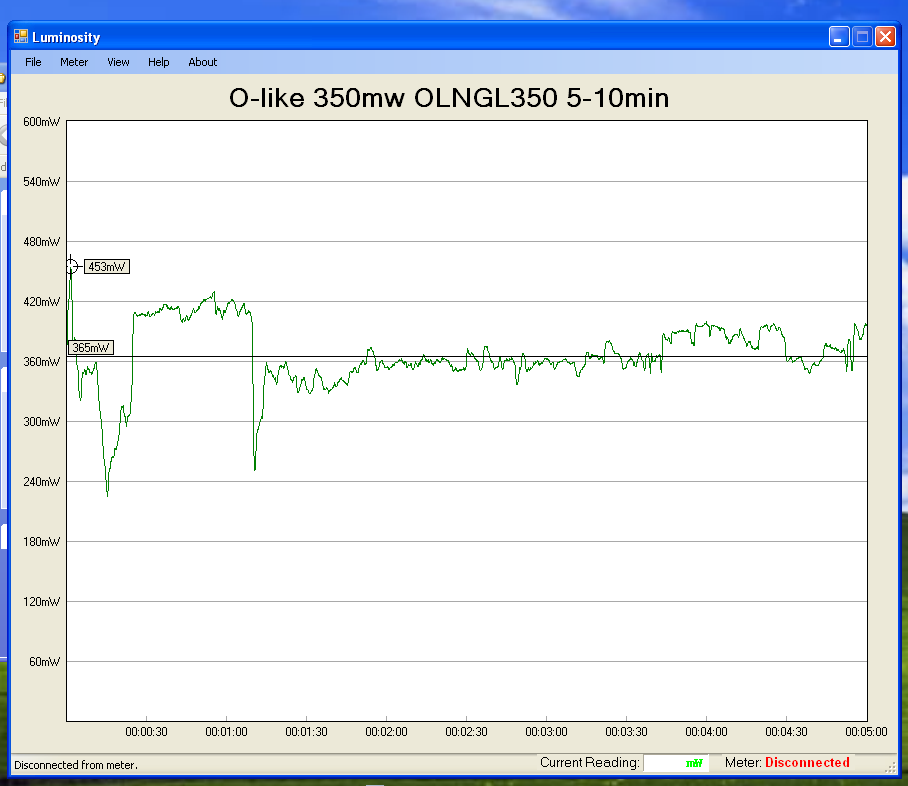
And here is 10-15 mins:
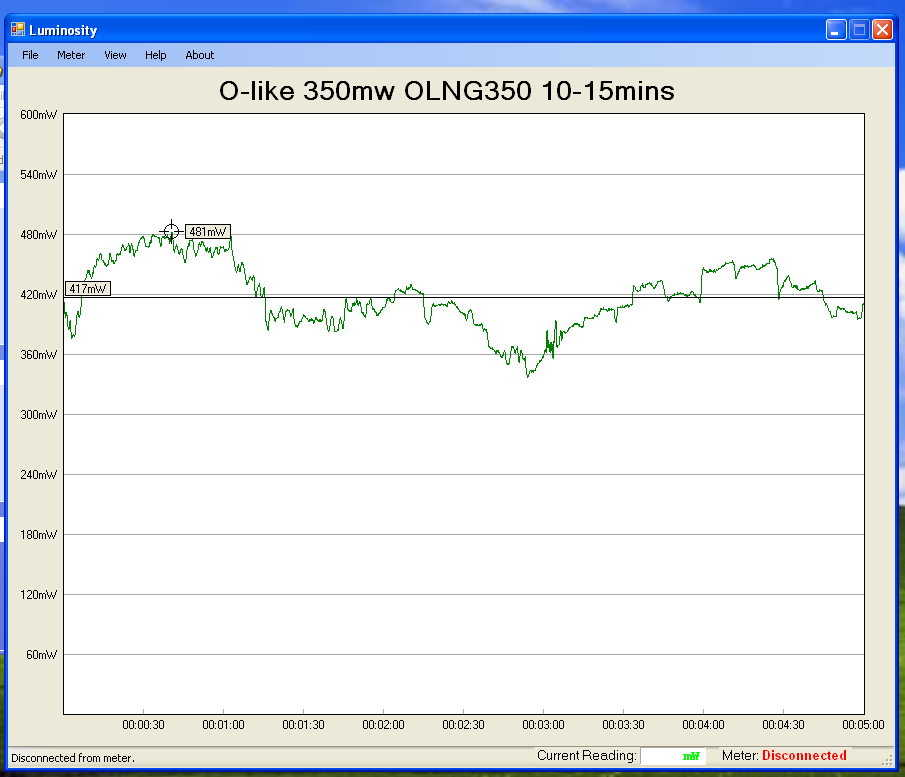
From the above, it appears the laser needs to be on for 6 minutes or so in order to stabilize. This is very interesting... I wonder if its a combination of larger Vanadate and KYT in combination with a large heatsink.
So I would say that this laser can be considered a continuous duty cycle laser for all intents and purposes. It was pretty stable after 15 mins of what was basically continuous output. However, I have noticed that the module likes to be warmed up first. Here are some more graphs experimenting with duty cycles after the laser was warmed up for those 15 minutes. As you can see, turning it off for 30-60 seconds and back on produced some impressive peak power outpus:
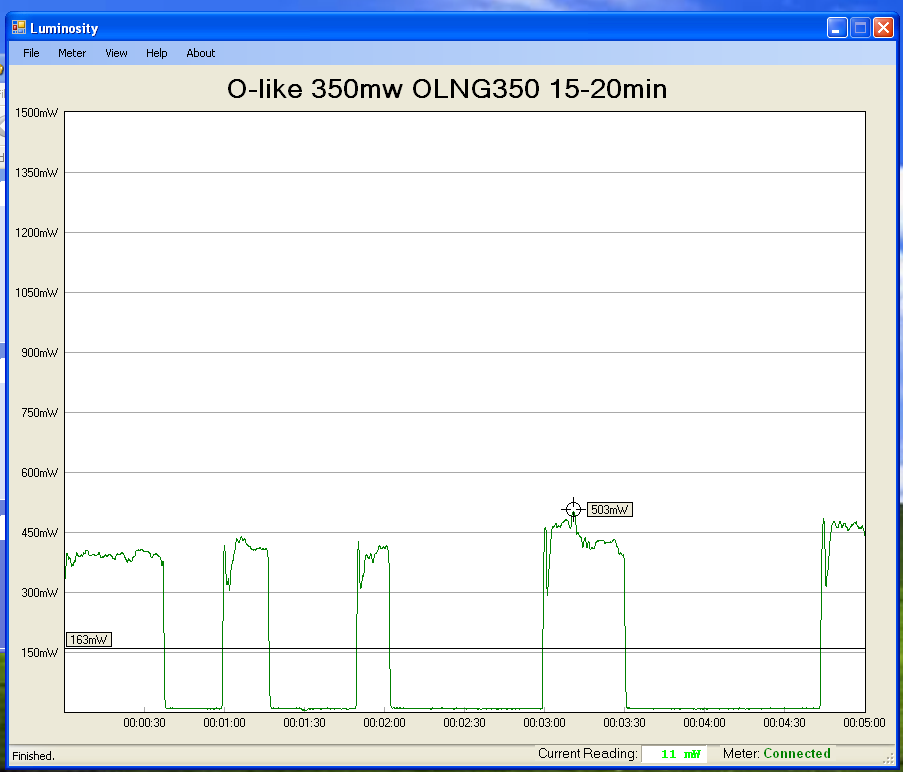
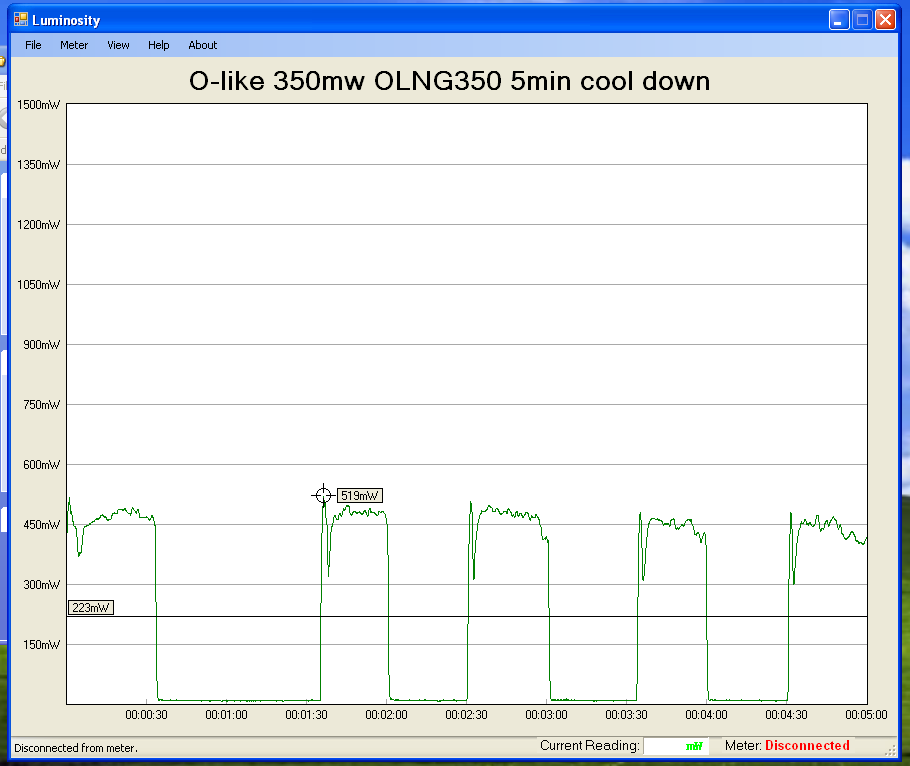
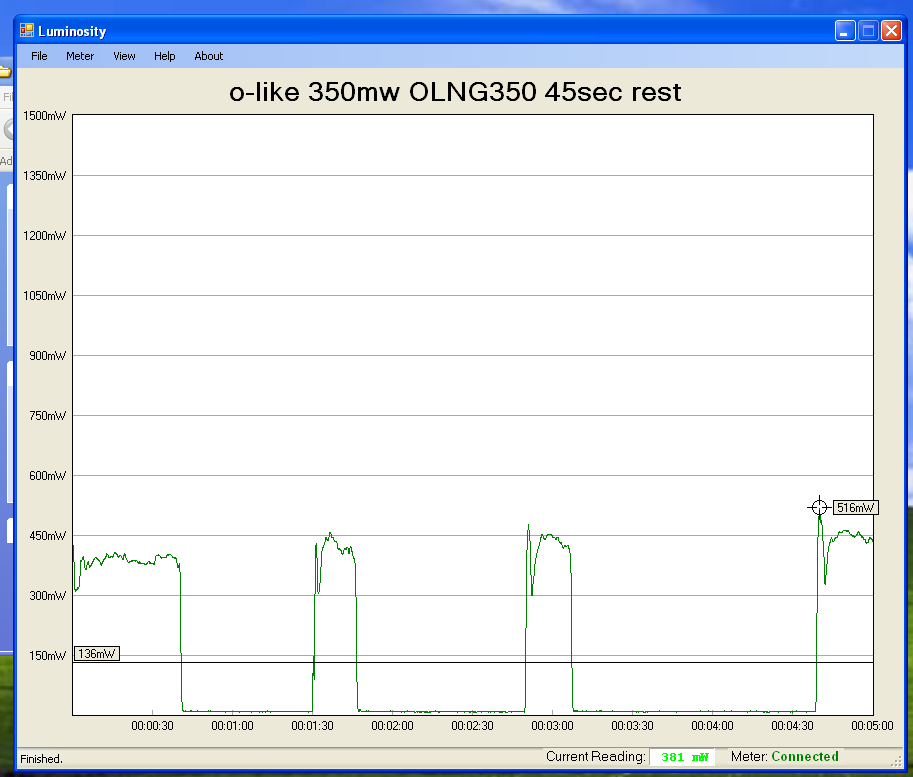
Here is a power plot from the laser at room temperature, not having been run for a day, with a freshly charged battery, for 15 minutes. Note how it takes about 7.5 minutes to stabilize. After that for the other 7.5 minutes it runs within an average of about 390mw +/- 30mw. After the 15 min the laser was pretty warm. I was lazy and didn't record a temperature graph while it was running (with my logging digital thermocouple) but one day i will do this. Also note this was done with NO IR filter. So revise the numbers down about 10% for just the 532nm light.
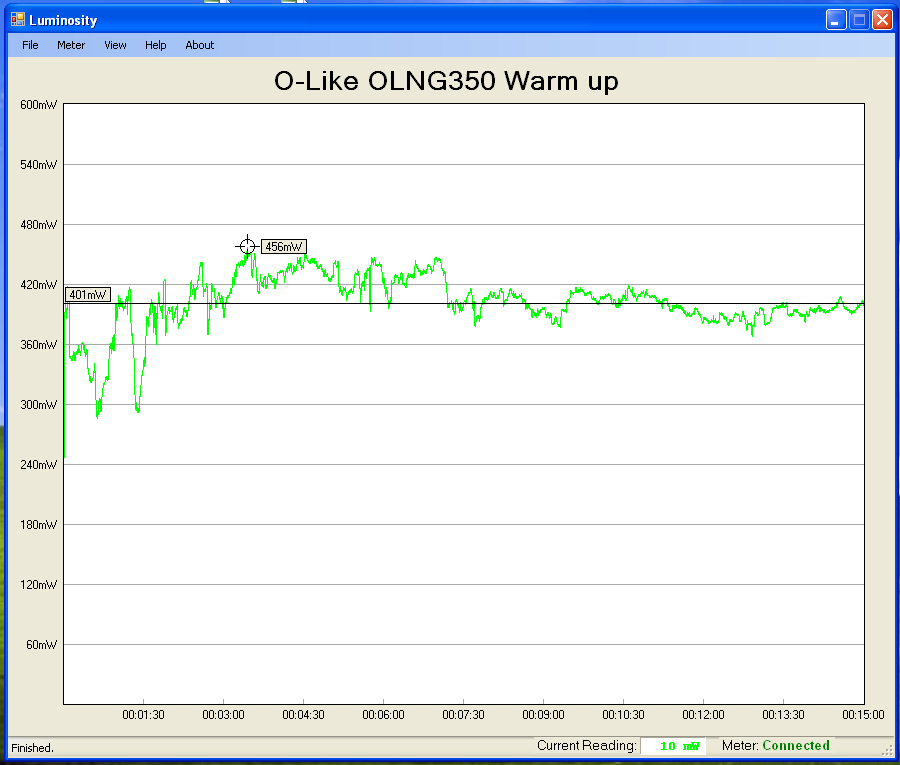
Beamshots
Here are some beamshots. This photo includes an 880mW 445nm WL Arctic, 560mW 405nm and O-like "Cute" 250mw 650nm, for comparison:
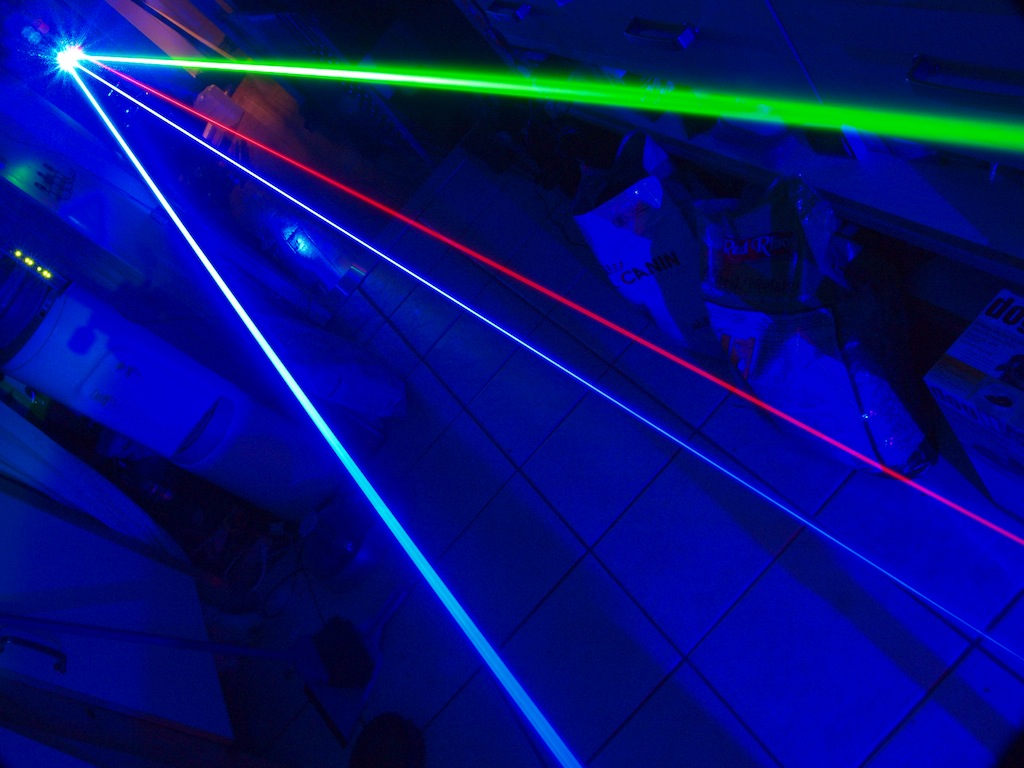
Conclusion
I am very impressed with this laser. The high quality construction, ample heatsink and great output characteristics are impressive and well worth the $295US price tag. The IR content is pretty typical of this kind of DPSS laser. The stock IR filter should be replaced with a better BK38 or equivalent filter to effectively eliminate IR in the output, otherwise there will be unsafe levels of IR in the beam. I do not consider 532nm lasers the best for burning so I am not going to go into detail on burning capabilities. 532nm is the best for visibility and you can see this in the beamshot. The visible output is quite impressive. Over-all a very recommended laser.
I purchased this laser 9 Feb 2011 but because of the Chinese New Year I did not get a shipping notification until 15 Feb. It was shipped out on 16 Feb by the optional DHL express service. It arrived in my hand on 17 Feb (!!!) Very fast and worth the extra $15 (to me).
Appearance & Features
The laser is very well machined with a nice smooth semi-gloss surface that feels very top quality.
Here it is compared with some other lasers (from bottom to top: Wicked Lasers Arctic, O-like OLNG350, Wicked Lasers E3, Aurora SH302 host, O-like "Cute" 250mw 650nm):
The tail cap has a key switch on it. this is actually very useful and provides for a good safety feature. the annoyance of having to use the key to arm the laser, or not is out-weighed by the safety aspect of it. The positive tail cap is well made and serviceable"
The power switch is very nice and feels nice. its a soft press toggle on/off. when off it glows blue and when on it glows red. there is no time delay.
The switch is illuminated blue when the key switch is on (armed mode) and red when the laser is on. You can see the switch is illuminated with 3 board mounted LEDs.
The front aperture has a manual aperture lever. pushing the lever down opens the aperture leaf and pushing it towards the aperture, closes the aperture. this is another good safety feature. i always make sure to close the aperture before i turn the laser on and then use the aperture lever to open it. this way i don't inadvertently turn the laser on while its pointed at something i don't want it to be (like my eyes). also the main switch is very soft touch so its easy to accidentally turn the laser on by accident. so the aperture leaf is a welcome safety feature.
one gripe i have is that when the laser is keyed-on the blue lights are on. this means there is power draw and you have to make sure to key-off the laser before putting it to bed for the night, or else your battery will drain. but like i said having the key switch is better than not and it forces me to only key-on the laser when i am going to use it (safety).
The heat sink is quite massive and I think it might be made of brass, considering the weight of the laser and the balance of the weight toward the head. The main focusing lens is on a thin but wide disk that threads into the heat sink (I have removed the IR fliter, and the residual white silicone can be seen):
Internal Design
This is module with the focusing lens removed. you can see a secondary lens glued to the output of the module. the lenses appear to be glass:
The battery compartment is a plastic sleeve inside the host. This makes the battery fit nice and snug but with enough clearance to slide out without effort. The inner battery spring has no other support so this could be a problem in the future with perhaps the spring coming loose. I hope there is a good blob on solder holding it to the driver!
I think they are using a constant current driver because as the battery depletes the output remains quite constant (unlike the "cute" 250mw 650nm which I think is a linear driver as the output of the laser drops as the battery drains).
IR Output
I measured the stock IR filter vs another IR filter. the other IR filter i purchased from ebay and seem to be a common one used with laser diodes. however i don't know which does the best job of only filtering IR.
The stock filter is a thin piece of glass that has no tint. When the laser was outputting an average of 380mw, the stock IR filter reduced this down by 20mW, or 5.2% of total. The other IR filter (Schott BK38) dropped this down by 60mW, or 15.8% of total - 3x more IR attenuation. In the meantime I ordered a lab grade visible light pass-through filter from an ebay seller so I can get a better handle on how much IR my lasers are producing. But BK38 is pretty standard so I think the stock IR filter is only reducing the IR marginally and I would say is still at an unsafe level. BK38 attenuates the 800-1100nm region down to about 2-4%.
As a note, there is a lot of interest in DPSS lasers with IR filters in terms of whether they have them or not and how much IR is produced. We all want to trust the rating manufactures give us and we've all seen some lasers that produce upwards of 30% of their output as IR. Some people have used cheap goggle to filter out IR or even IR filters made for laser pointers. Unless a filter is used that has a measured spectral response, you will never really know for sure. If you are concerned or interested in measuring IR vs Visible you might want to consider buying a measured and documented filter for such purposes. There are often lab grade filters on ebay. When I get mine I will update this review and we will then be able to say for sure how much IR this produces.
For now, lets say the laser produces somewhere between 5-15% of IR in its total output, which pretty typical.
UPDATE: I just realized I have two IR filters for photography. Ones happens to cut off under 950nm and the other under 720nm. so perfect for measuring the IR in these DPSS lasers! also these are pretty high quality filters and I believe they are at least 85% transmissive if not more.
With the 720nm pass through I read 40mw and with the 950nm i read 26mw. so that means about 13mw of 808nm and 26mw of 1062nm. so this tells us that the stock IR filters is still letting through about 20mw of IR and that the Schott BK38 is cutting an additional 20mw of the 532nm output. for this laser, when outputting 420mw of total power to only have 40mw of IR is pretty good!
Here is a horizontal beam comparison between some similar lasers. The top is the OLNG350, middle is an Ultra Lasers 100mW pen and bottom is a 280mW labby. Notice how the OLNG350 has a wider beam waist and hence lower power density. This is, I think, because they are using larger crystals to keep the interface temperatures down. You still get more light out of it but in a wider area. The OLNG350 has a waist about twice that of the 100mW, which can use smaller crystals, and the labby which is TEC cooled. (This was a very difficult picture to capture.)
This is a picture of the laser output without the front most focusing lens.
This is the beam profile, without the front focusing lens, about 2m from the aperture. The beam profile is more rectangular than round. It is pretty stable but there is some mode hop now and again. The instability is more pronounced when the laser is cool:
Measurements
The graphs in this review are with the stock IR filter. I did them before I thought of trying the other IR filter. so adjust your expectations accordingly.
This graph shows a 5 minute run from room temperature on a fresh AW 18650 2600mAh:

Then I switched the laser off for about 10 seconds before I started the next run from 5-10 min:

And here is 10-15 mins:

From the above, it appears the laser needs to be on for 6 minutes or so in order to stabilize. This is very interesting... I wonder if its a combination of larger Vanadate and KYT in combination with a large heatsink.
So I would say that this laser can be considered a continuous duty cycle laser for all intents and purposes. It was pretty stable after 15 mins of what was basically continuous output. However, I have noticed that the module likes to be warmed up first. Here are some more graphs experimenting with duty cycles after the laser was warmed up for those 15 minutes. As you can see, turning it off for 30-60 seconds and back on produced some impressive peak power outpus:



Here is a power plot from the laser at room temperature, not having been run for a day, with a freshly charged battery, for 15 minutes. Note how it takes about 7.5 minutes to stabilize. After that for the other 7.5 minutes it runs within an average of about 390mw +/- 30mw. After the 15 min the laser was pretty warm. I was lazy and didn't record a temperature graph while it was running (with my logging digital thermocouple) but one day i will do this. Also note this was done with NO IR filter. So revise the numbers down about 10% for just the 532nm light.

Beamshots
Here are some beamshots. This photo includes an 880mW 445nm WL Arctic, 560mW 405nm and O-like "Cute" 250mw 650nm, for comparison:
Conclusion
I am very impressed with this laser. The high quality construction, ample heatsink and great output characteristics are impressive and well worth the $295US price tag. The IR content is pretty typical of this kind of DPSS laser. The stock IR filter should be replaced with a better BK38 or equivalent filter to effectively eliminate IR in the output, otherwise there will be unsafe levels of IR in the beam. I do not consider 532nm lasers the best for burning so I am not going to go into detail on burning capabilities. 532nm is the best for visibility and you can see this in the beamshot. The visible output is quite impressive. Over-all a very recommended laser.
Last edited:





